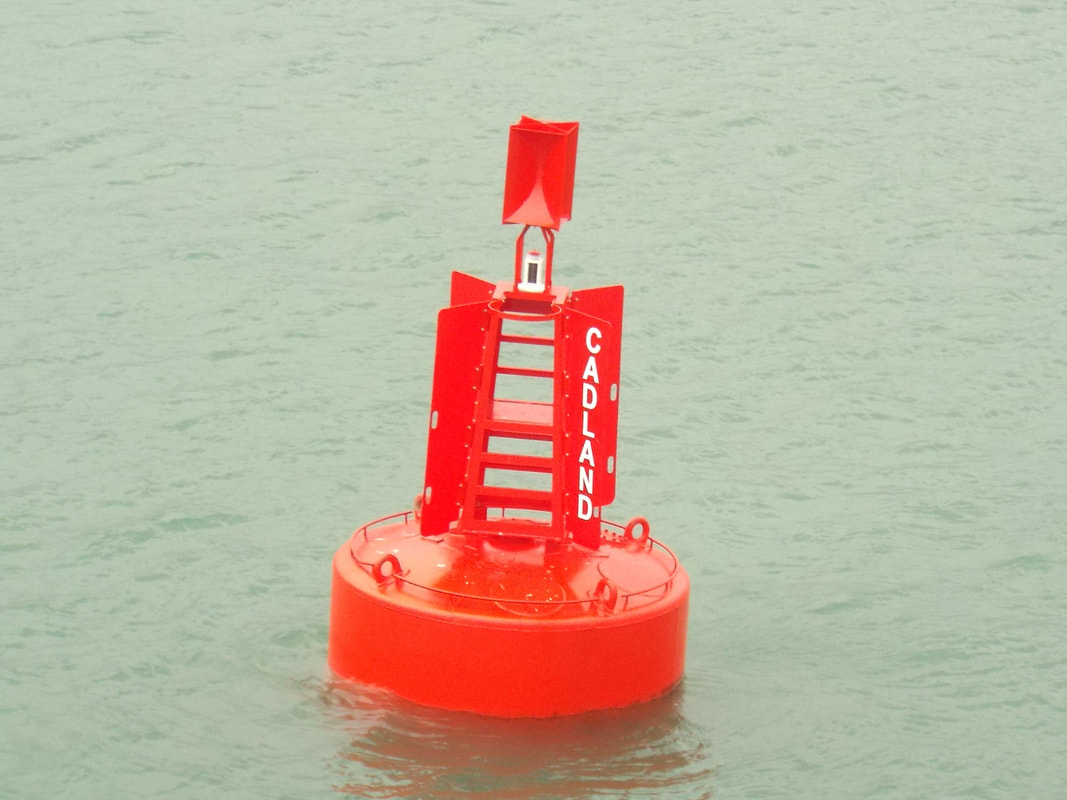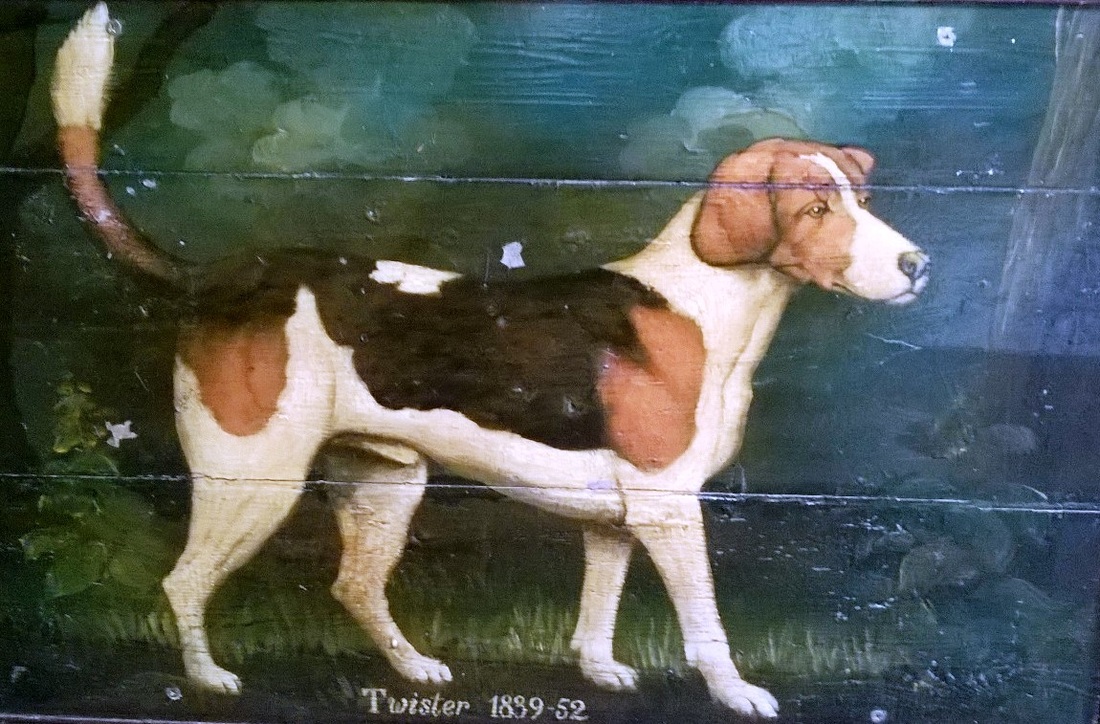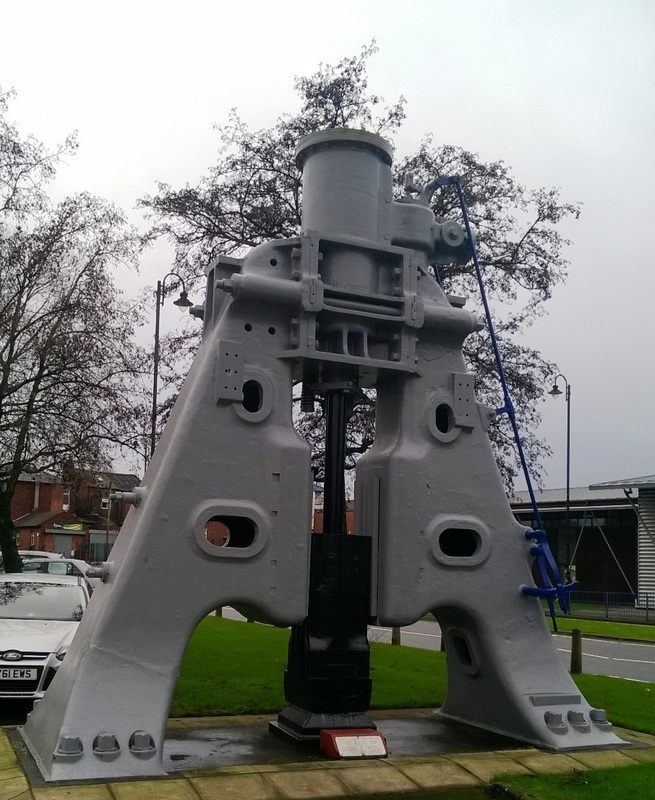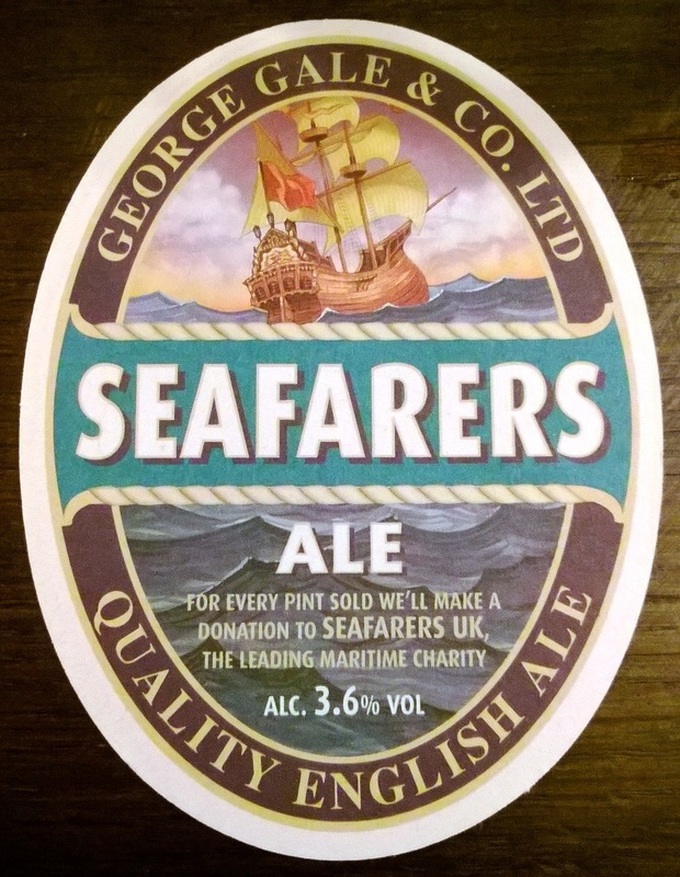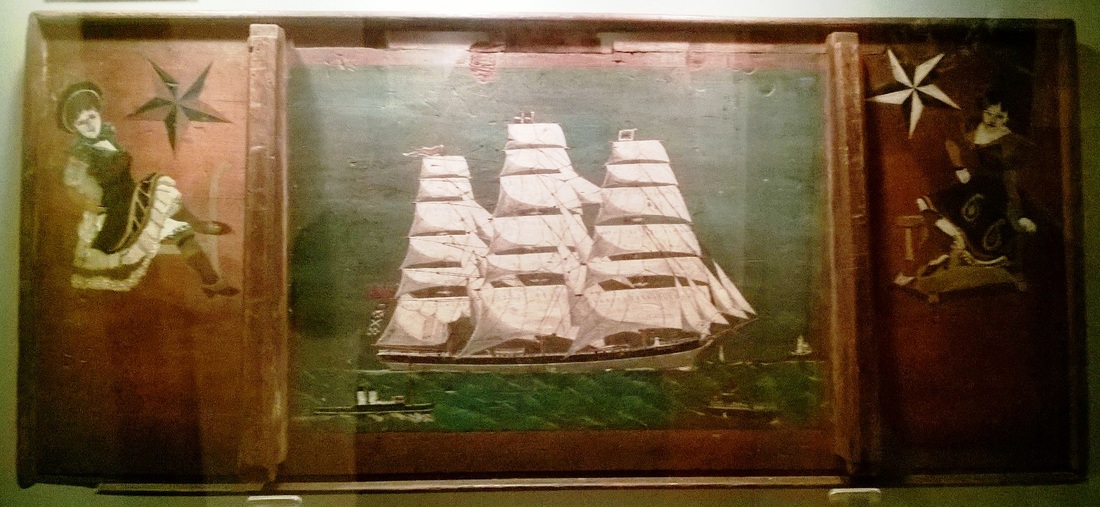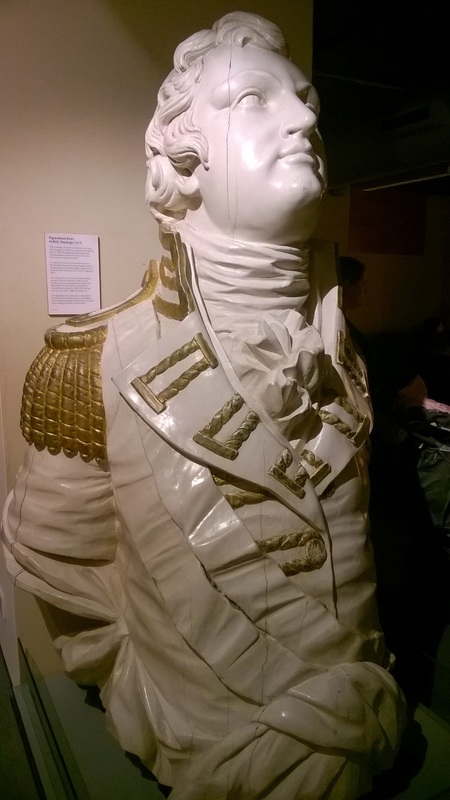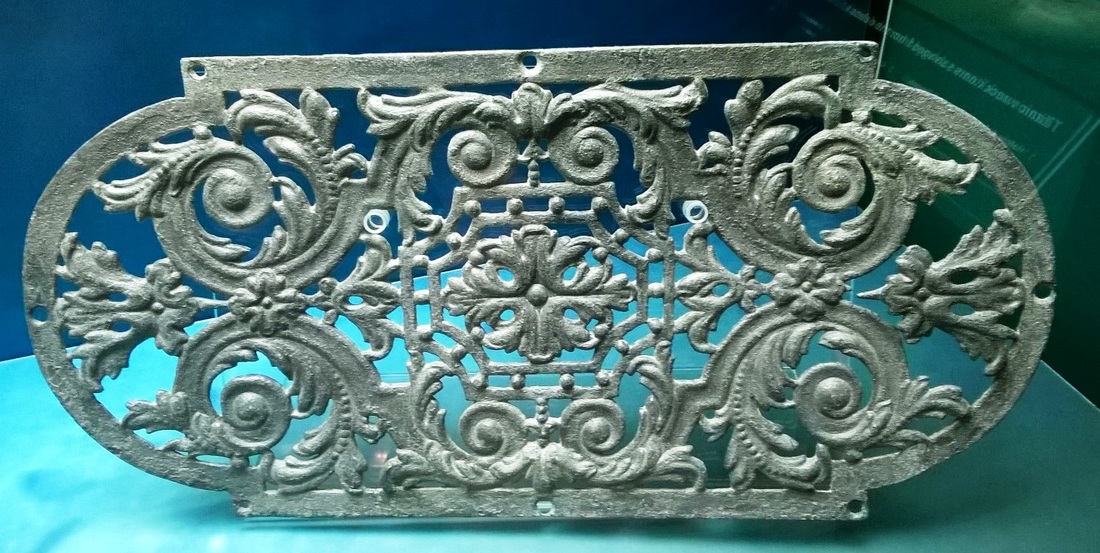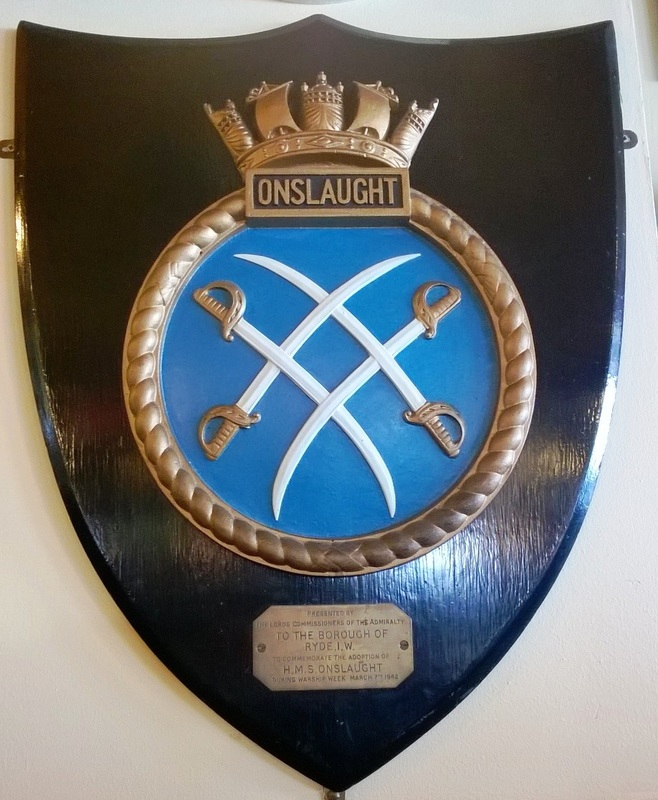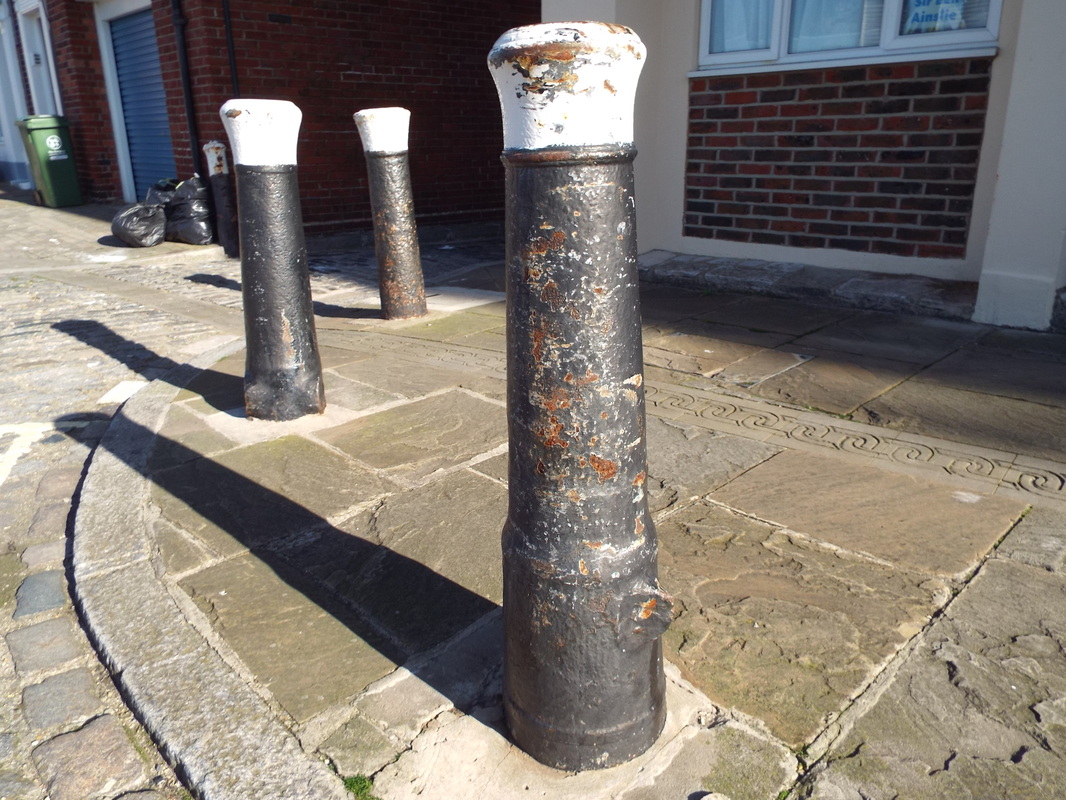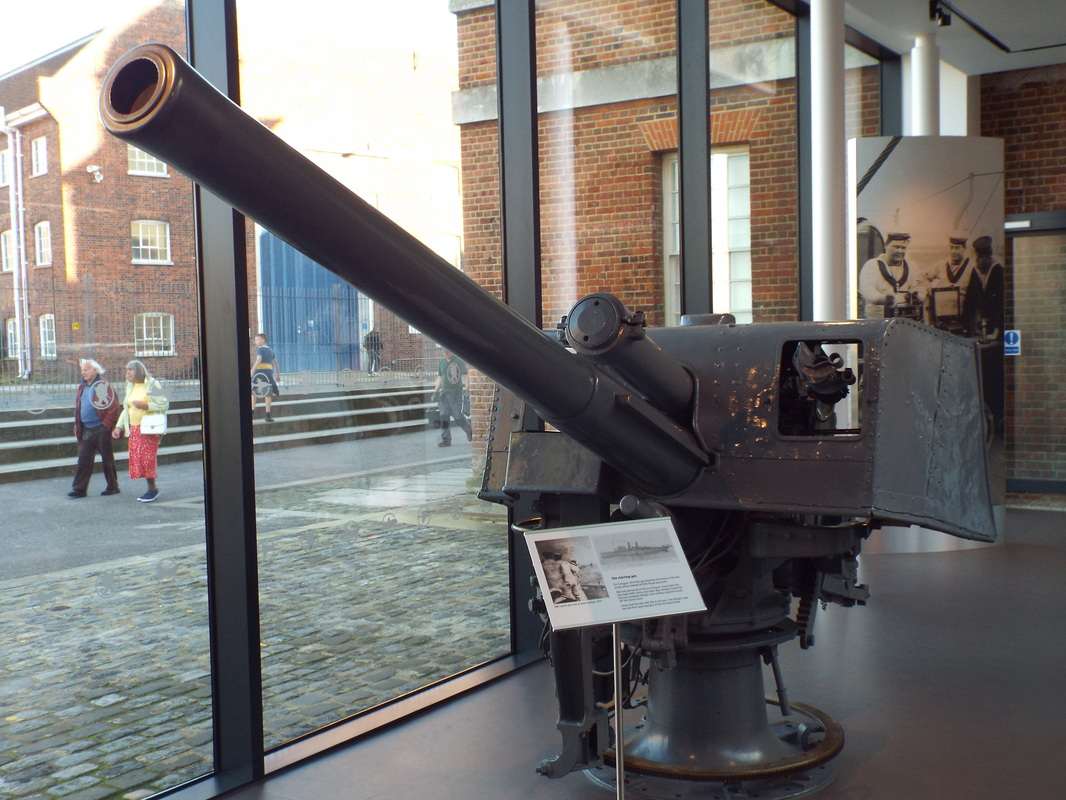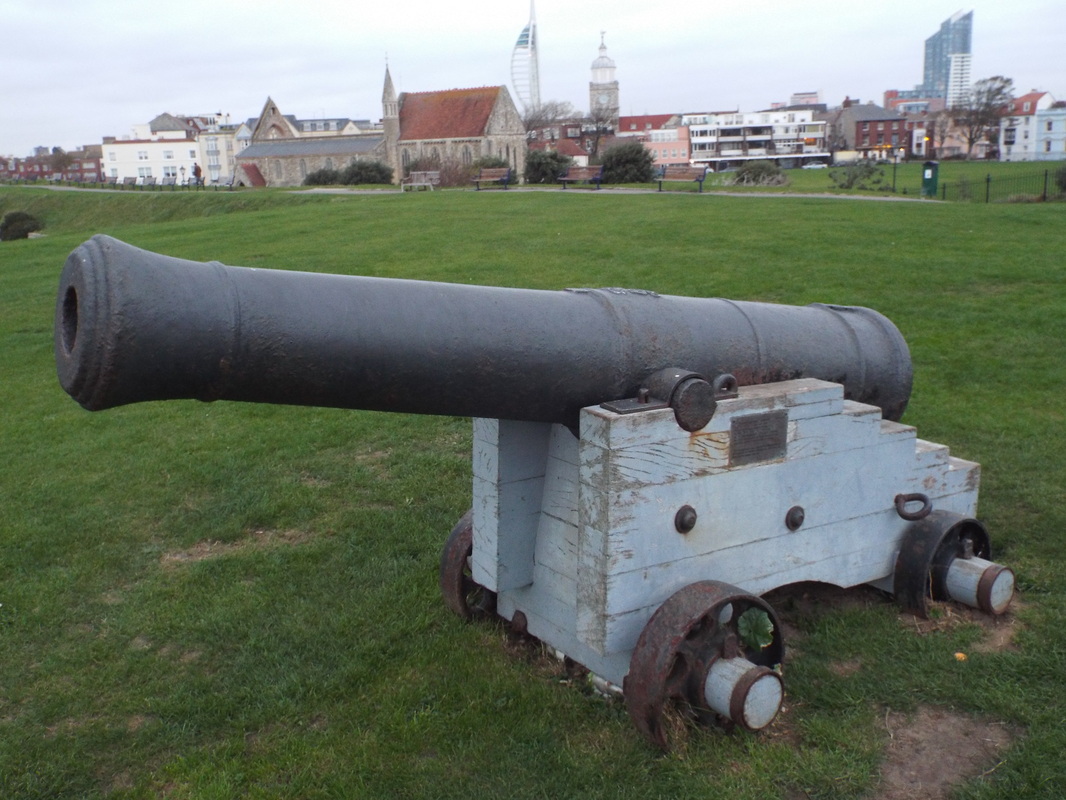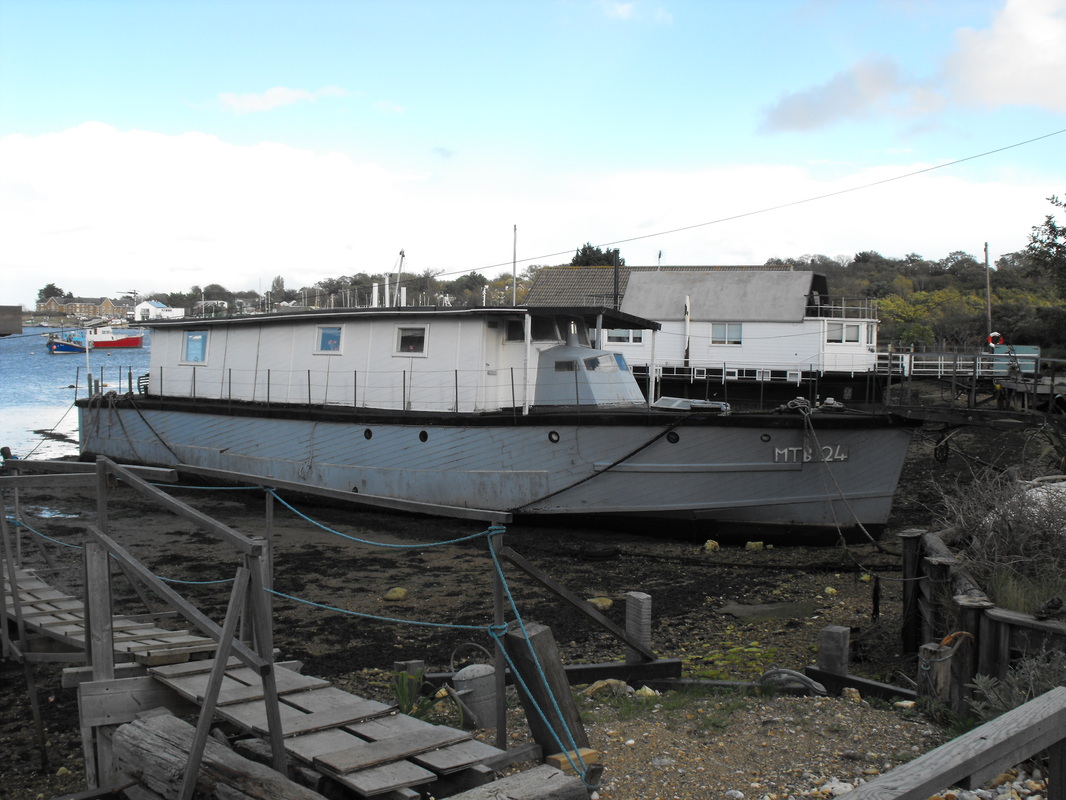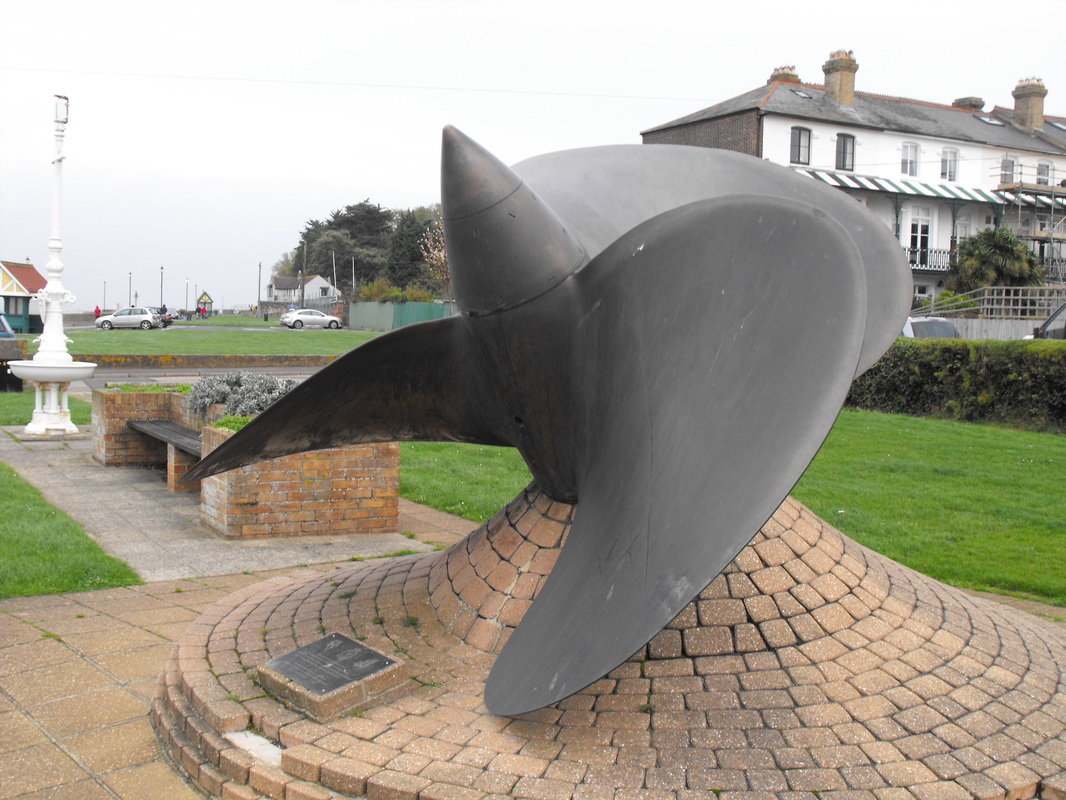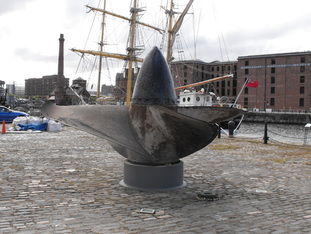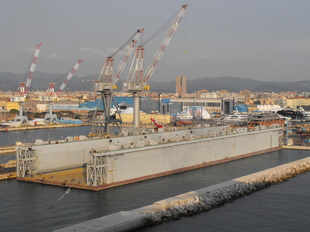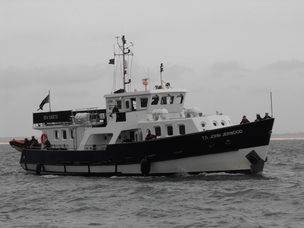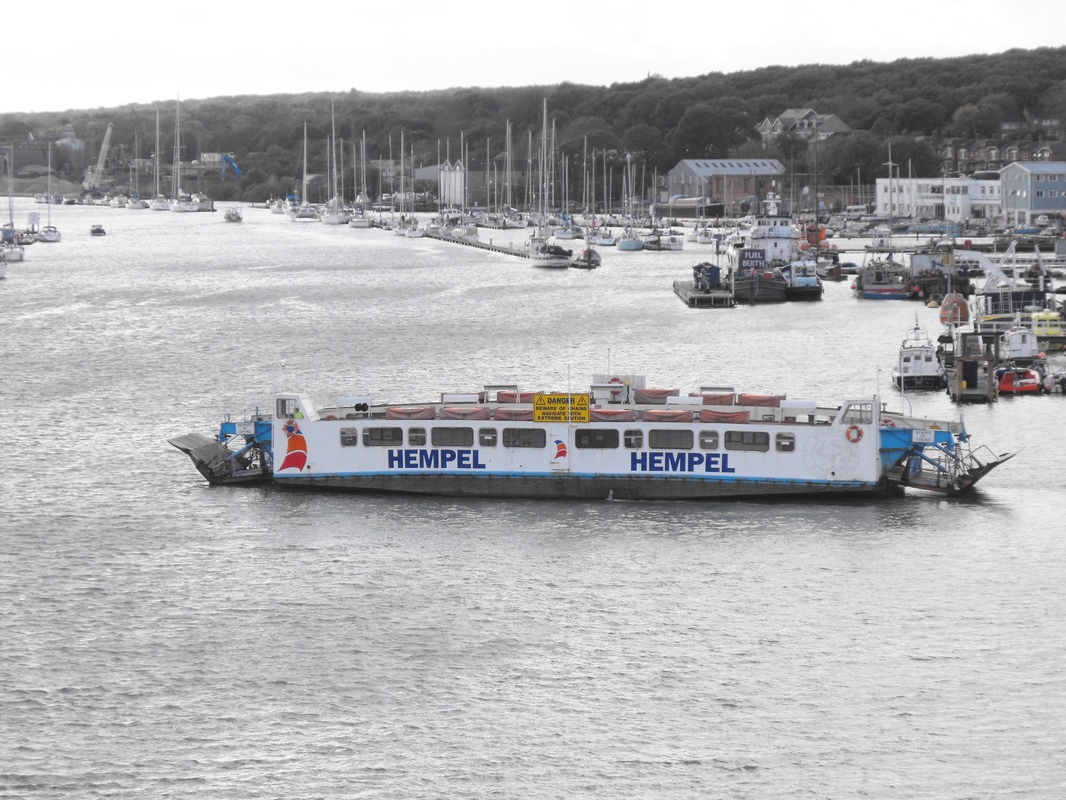CADLAND BUOY |
TWISTER - 1839 - 1852 |
|
Cadland Buoy looking immaculate on a very calm day. This is located in the main channel of the Solent. Photographed as I headed home from holiday on 23 October 2015.
|
I saw this painting in a pub on the Isle of Wight in October 2015. The painting was on three pieces of hardwood board that had been fastened together to form a rough canvas. Over the last 164 years the boards have moved / shrunk splitting the picture into three.
|
RUSSIAN FIELD GUN
I took the above photograph on 3 February 2016 after briefly stopping in Hale Village, Merseyside after a mid morning meeting nearby.
The gun sits alongside the villages war memorial.
The gun stated service with Russian forces in World War I. Captured by the German Army it was re-barrelled on its original chassis into a 3 Inch howitzer capable of firing an 18 pound high explosive shell up to 6500m. The gun was eventually captured again by allied forces.
The forward shield of the gun has hits by small arms fire.
The gun sits alongside the villages war memorial.
The gun stated service with Russian forces in World War I. Captured by the German Army it was re-barrelled on its original chassis into a 3 Inch howitzer capable of firing an 18 pound high explosive shell up to 6500m. The gun was eventually captured again by allied forces.
The forward shield of the gun has hits by small arms fire.
Nasmyth & WILSON STEAM HAMMER - 1917
Nasmyth & Wilson Steam hammer manufactured in 1917.
This was manufactured in Patricroft for Thomas Walmsley and Sons of Bolton and was used until 1975 to process wrought iron using the indirect or puddling process at the Atlas Forge.
The possibility of steam hammers was first noted by James Watt (1736-1819) in his 1794 patent for the steam engine. James Nasmyth (1808-1890) and Francois Bourdon (1797-1865) reinvented the steam hammer independently in 1839 as they were trying to solve the problem of forging cranks for steam engines of increasing size for use in locomotives and paddle steamers.
Nasmyth noted the need arose for a paddle shaft for Isambard Kingdom Brunel's new transatlantic steamer the SS Great Britain which with a 760mm shaft diameter was larger than any that had previously been forged. He sketched a proposal for his steam hammer design in 1839 but the need disappeared when the SS Great Britain was converted to screw propellers.
Bourdon came up with an idea for a steam hammer also in 1839 and made detailed drawings of his proposal. Bourdon built the first steam hammer in the world in 1840 at the Schneider & Cei works at Le Creusot after the Bourdon and Schneider had visited the Nasmyth works in England and been shown his sketch.
Nasmyth visited Le Creusot in April 1842 to see the hammer working and built his own steam hammer later in 1842 after returning from France.
The design of the steam hammer continued to improve although during the 20th Century they became obsolete in heavy industry due to the advent of more advanced technologies in the form of hydraulic and mechanical presses.
Atlas Forge was founded in the 1860's by Thomas Walmsley & Sons in Bolton not far from where the steam hammer I photographed now sits. They produced wrought iron until 1975 and were the last wrought iron manufacturer in the UK.
Naysmyth and Wilson was founded in 1836 in Patricroft, Salford, England and was located close to the Liverpool and Manchester Railway, Bridgewater Canal and Manchester Ship Canal.
Photographed as I walked from a meeting in Bolton, Lancashire, UK on the 4 January 2016 - This was my first day back after the Christmas holidays.
This was manufactured in Patricroft for Thomas Walmsley and Sons of Bolton and was used until 1975 to process wrought iron using the indirect or puddling process at the Atlas Forge.
The possibility of steam hammers was first noted by James Watt (1736-1819) in his 1794 patent for the steam engine. James Nasmyth (1808-1890) and Francois Bourdon (1797-1865) reinvented the steam hammer independently in 1839 as they were trying to solve the problem of forging cranks for steam engines of increasing size for use in locomotives and paddle steamers.
Nasmyth noted the need arose for a paddle shaft for Isambard Kingdom Brunel's new transatlantic steamer the SS Great Britain which with a 760mm shaft diameter was larger than any that had previously been forged. He sketched a proposal for his steam hammer design in 1839 but the need disappeared when the SS Great Britain was converted to screw propellers.
Bourdon came up with an idea for a steam hammer also in 1839 and made detailed drawings of his proposal. Bourdon built the first steam hammer in the world in 1840 at the Schneider & Cei works at Le Creusot after the Bourdon and Schneider had visited the Nasmyth works in England and been shown his sketch.
Nasmyth visited Le Creusot in April 1842 to see the hammer working and built his own steam hammer later in 1842 after returning from France.
The design of the steam hammer continued to improve although during the 20th Century they became obsolete in heavy industry due to the advent of more advanced technologies in the form of hydraulic and mechanical presses.
Atlas Forge was founded in the 1860's by Thomas Walmsley & Sons in Bolton not far from where the steam hammer I photographed now sits. They produced wrought iron until 1975 and were the last wrought iron manufacturer in the UK.
Naysmyth and Wilson was founded in 1836 in Patricroft, Salford, England and was located close to the Liverpool and Manchester Railway, Bridgewater Canal and Manchester Ship Canal.
Photographed as I walked from a meeting in Bolton, Lancashire, UK on the 4 January 2016 - This was my first day back after the Christmas holidays.
SS LLANSTEPHAN CASTLE - MENU
Framed menu from the SS Llanstephan Castle I saw in a pub on the Isle of Wight last week.
This was difficult to photograph due to the glass reflecting the lights in the pub but you can make out what was on the menu, interestingly it is written in French, shame that it is not dated.
The SS Llanstephan Castle was a Union Castle line vessel that was built in 1914. She was just over 500ft long, GT 11,348 had four holds and accommodated 213 First Class, 116 Second Class, and 100 Third Class passengers.
As soon as she was delivered she departed London on her maiden voyage to East and South Africa. During her second voyage on the homeward sailing, a report came to the captain that the German cruiser “Konigsberg” was in the vicinity and the ship was turned around. Upon arrival in Durban Union-Castle transferred her to the London, South African West coast service.
In 1917 she was requisitioned for the war effort and placed in the North Atlantic transporting troops.
After the war she returned to the company and was made ready to return on the London, Cape Town service. In 1920 she was placed on the East African service. Another change took place in 1922 when she was transferred to the “Round Africa” service, visiting Naples or Genoa, Suez, Aden, Mombasa, Tanga, Dar-es-Salaam, Beira, Lourenco Marques, Durban and East London, Cape Town returning via West Africa.
In 1938 she received a refit and at the same time she was converted from coal to oil fuel saving a considerable amount for the company.
During the Second World War she first operated as a military troop transport ship for the Ministry of War. However in August 1940 she transported 300 evacuees from Liverpool to Cape Town the majority of which were children. A year later in 1941 she departed Liverpool in charge of a convoy and transported some 200 Polish airmen released from prison. She continued to operate in the Far East but was later transferred to the Royal Indian Navy.
After World War II she was returned to Union Castle Line who had her refitted turning her into a two class ship accommodating 231 First Class and 198 Tourist Class passengers. Upon completion she returned to her pre war round Africa service.
In March 1952 the aging Llanstephan Castle was withdrawn from service and sold to the British Iron & Steel Corporation who delivered her to J. Cashmore shipyards at Newport, Monmouthshire, Wales where she was broken up.
This was difficult to photograph due to the glass reflecting the lights in the pub but you can make out what was on the menu, interestingly it is written in French, shame that it is not dated.
The SS Llanstephan Castle was a Union Castle line vessel that was built in 1914. She was just over 500ft long, GT 11,348 had four holds and accommodated 213 First Class, 116 Second Class, and 100 Third Class passengers.
As soon as she was delivered she departed London on her maiden voyage to East and South Africa. During her second voyage on the homeward sailing, a report came to the captain that the German cruiser “Konigsberg” was in the vicinity and the ship was turned around. Upon arrival in Durban Union-Castle transferred her to the London, South African West coast service.
In 1917 she was requisitioned for the war effort and placed in the North Atlantic transporting troops.
After the war she returned to the company and was made ready to return on the London, Cape Town service. In 1920 she was placed on the East African service. Another change took place in 1922 when she was transferred to the “Round Africa” service, visiting Naples or Genoa, Suez, Aden, Mombasa, Tanga, Dar-es-Salaam, Beira, Lourenco Marques, Durban and East London, Cape Town returning via West Africa.
In 1938 she received a refit and at the same time she was converted from coal to oil fuel saving a considerable amount for the company.
During the Second World War she first operated as a military troop transport ship for the Ministry of War. However in August 1940 she transported 300 evacuees from Liverpool to Cape Town the majority of which were children. A year later in 1941 she departed Liverpool in charge of a convoy and transported some 200 Polish airmen released from prison. She continued to operate in the Far East but was later transferred to the Royal Indian Navy.
After World War II she was returned to Union Castle Line who had her refitted turning her into a two class ship accommodating 231 First Class and 198 Tourist Class passengers. Upon completion she returned to her pre war round Africa service.
In March 1952 the aging Llanstephan Castle was withdrawn from service and sold to the British Iron & Steel Corporation who delivered her to J. Cashmore shipyards at Newport, Monmouthshire, Wales where she was broken up.
SEAFARERS ALE
|
A beer mat that I picked up earlier in the year in Cowes and forgot about until I was preparing my overnight bag last week.
George Gale and Co were founded in 1847 but in more recent times have been bought by a much larger company. It was originally developed as a tribute to Gales close association with all who sail on the seas and for every pint sold a donation is made to Seafarers UK which a maritime charity. Ale's are not my kind of drink but it is advertised as having well developed fruity malt flavours and gentle bitterness sailing through to a satisfying hoppy finish. |
PAINTED TOOL BOX LID - 1898
The inside of a tool box lid painted circa 1898 by Hugh Owens who was a ships carpenter.
The ship depicted is called the Hugh & Mary which may be a real vessel or perhaps one named after himself and his wife.
Photographed in Liverpool Museum, 2 May 2015.
The ship depicted is called the Hugh & Mary which may be a real vessel or perhaps one named after himself and his wife.
Photographed in Liverpool Museum, 2 May 2015.
6 POUNDER CARRONADE
Carronade photographed in the Isle Of Wight in April 2015.
This is a very small 6 pounder version of a weapon widely used during the 18th and 19th Centuries.
This particular 6 Pounder dates to approximately 1800, has a barrel length of 43 inches and is bored to take a 6 lb (3.6 inch) ball, the mounting is an iron garrison carriage which gives the gun an overall length of 50 inches and a total weight of 6cwt 13lbs.
The name carronade is attributed to the Carron Company of Falkirk, Scotland who produced these types of weapons from 1776. Initially the weapons were known as Marine Guns and those produced were sold to chiefly British and Spanish merchants who had to arm their own vessels, the guns were lighter than 'long' guns which was important to merchant vessels who at the time had to deal with privateers and American Naval vessels prowling off the British Isles.
This 'Marine' gun was in effect a prototype of the Carronade, the first carronades were installed on a ship called Spitfire which was of 200t and at the time fitting out in Liverpool. Spitfire was soon in action and reportedly did very well despite heavy odds.
The new weapon was also in demand by privateers sailing against vessels from America, the Captain of the Sharp of Glasgow attributed a victory in an engagement off Cape Clear to the new gun as did the Hawke (also from Glasgow) which fought off two privateers in the Bay of Biscay in July 1779.
The carronade had appeal because it offered a large calibre for relatively little size and weight, a 42 pounder carronade was shorter than a 3 pounder long gun and weighed less than a 12 pounder. Another advantage was a carronade took less men to operate, the normal crew for a 24 pounder long gun was 11men whilst a 42 pounder carronade could be operated by a crew of 4. The carronade was also easier and quicker to load and fire with 11 broadsides to an enemies 3 reported. Its main disadvantage was that it did not have the range of the long guns which ultimately proved a serious problem if a carronade armed vessels could not close the distance with a long gun armed opponent, in effect they could not effectively fire back, another disadvantage was excessive recoil particularly when the gun was double shotted which could also result in the dismounting of the gun from its carriage.
The guns were introduced into British naval service in 1779 and were produced in sizes up to 68 pounder, by January 1781 429 Royal Navy ships mounted 604 carronades
The last Carronade was manufactured in 1852 although they had started to be replaced by the Royal Navy well before this.
This is a very small 6 pounder version of a weapon widely used during the 18th and 19th Centuries.
This particular 6 Pounder dates to approximately 1800, has a barrel length of 43 inches and is bored to take a 6 lb (3.6 inch) ball, the mounting is an iron garrison carriage which gives the gun an overall length of 50 inches and a total weight of 6cwt 13lbs.
The name carronade is attributed to the Carron Company of Falkirk, Scotland who produced these types of weapons from 1776. Initially the weapons were known as Marine Guns and those produced were sold to chiefly British and Spanish merchants who had to arm their own vessels, the guns were lighter than 'long' guns which was important to merchant vessels who at the time had to deal with privateers and American Naval vessels prowling off the British Isles.
This 'Marine' gun was in effect a prototype of the Carronade, the first carronades were installed on a ship called Spitfire which was of 200t and at the time fitting out in Liverpool. Spitfire was soon in action and reportedly did very well despite heavy odds.
The new weapon was also in demand by privateers sailing against vessels from America, the Captain of the Sharp of Glasgow attributed a victory in an engagement off Cape Clear to the new gun as did the Hawke (also from Glasgow) which fought off two privateers in the Bay of Biscay in July 1779.
The carronade had appeal because it offered a large calibre for relatively little size and weight, a 42 pounder carronade was shorter than a 3 pounder long gun and weighed less than a 12 pounder. Another advantage was a carronade took less men to operate, the normal crew for a 24 pounder long gun was 11men whilst a 42 pounder carronade could be operated by a crew of 4. The carronade was also easier and quicker to load and fire with 11 broadsides to an enemies 3 reported. Its main disadvantage was that it did not have the range of the long guns which ultimately proved a serious problem if a carronade armed vessels could not close the distance with a long gun armed opponent, in effect they could not effectively fire back, another disadvantage was excessive recoil particularly when the gun was double shotted which could also result in the dismounting of the gun from its carriage.
The guns were introduced into British naval service in 1779 and were produced in sizes up to 68 pounder, by January 1781 429 Royal Navy ships mounted 604 carronades
The last Carronade was manufactured in 1852 although they had started to be replaced by the Royal Navy well before this.
FIGUREHEAD, HMS HASTINGS - 1819 |
FIGUREHEAD, HMS ILLUSTRIOUS - 1803 |
|
Figurehead from HMS Hastings.
She was built in Calcutta by Kyd & Co for the East India Company in 1818 as a speculation and acquired by the British Navy in June 1819. The figurehead represents Lord Hastings who was Governor General of India at the time. HMS Hastings was a 74 gun third rate ship of the line. She was approximately 53.9m long with a 14.8m beam and was 1763 t. Armament consisted of 28 No. 32 pounder guns on the main gun deck with 28 No. 18 pounder guns on the upper gun deck. 4 No. 12 pounder guns on the quarterdeck with 10 No. 32 pounder carronades. 2 No. 12 pounders and 2 No. 32 pounder carronades were also located on the focsul. In 1834 she was commanded by Captain Schiffer and was the flagship of Rear-Admiral Sir William Hall Gage in Lisbon. Between 1838 and 1842 she operated in the Mediterranean including operations off the coast of Syria in 1840. Between 1848 and 1853 she operated in the East Indies. In 1855 she was converted to screw propulsion and joined the Baltic Fleet. The ship served in Liverpool as a coastal defence vessel between 1857 and 1860 and between 1860 and 1862 was a reserve drill ship based in Liverpool. Between 1862 and 1866 she was operating in Queenstown until 1870 when she became a coal hulk in Devonport before being sold in 1885. In 1866 she was broken up. The figurehead was on display at the Liverpool salesroom of shipbrokers CW Kellock & Company for many years before being presented to Liverpool Maritime Museum where I photographed it on 2 May 2015. |
Figurehead from the Battleship HMS Illustrious photographed in Portsmouth on 7 April 2015.
The figure head is of King George III. HMS Illustrious was a 74 gun Fame Class battleship ship of the line, she was ordered on 4 February 1800 and built and launched by Randall & Brent at Rotherhithe on the River Thames in September 1803, as a third rate vessel she was one of the most common battleships in the Royal Navy and saw service all over the world. She had a length of 53m with a 14.48m beam. Armament consisted of 28 No. 32 pounders on the main gun deck with 28 No. 1 pounders on the upper gun deck, 14 No. 9 pounders were also located on the quarter deck with a further 4 No. 9 pounders on the focasle. In 1803 she was commanded by a Captain William Shield and in 1804 under the command of Captain Sir Charles Hamilton sailed from Deal with HMS Imperieuse and HMS Squirrel together with a number of sloops and gunbrigs to cruise off Boulogne. In April 1804 she sailed again with HMS Immortalite, HMS Squirrel and HMS Seine and a number of small vessels to escort block ships filled with stone to sink at the entrance to Boulogne harbour. In September 1804 she recaptured the vessel Mary of Greenock which was trying to get to a port in Spain after being captured by the French privateer Uncle Tom during her outward bound passage to the West Indies. In 1805 together with HMS Ajax she detained the Spanish ship Santa Maria which had sailed from Havana with a valuable cargo consisting of 10,000 dollars, several hundred ounces of gold in dust and ingots, 140 bales of cotton, 150 bales of wool, hides, hogsheads of beef, cocoa and sheets of copper. Later in 1805 she was with Vice Admiral Collingwoods squadron of six 74's off the coast of Spain and on 7 July 1805 she and HMS Ramillies captured the French privateer schooner Josephine of 2 guns and 35 men. In the autumn she escorted home a large convoy from the Leeward Is. During 1806 and 1807 she was involved in the blockage of Cadiz. In 1809 she was involved in the attack on the French fleet in the Basque Roads and in 1811 assisted in the taking of the fortified camp of Meester Cornelis which after bombardment was captured following an assault by troops and marines, during this action the Illustrious had one sailor killed a second sailor missing ashore and three marines were wounded. In 1810 she was part of the fleet that captured the Ile de France and in 1811 took part in the Invasion of Java. Following a refit in Portsmouth she was laid up in reserve until 1832 when she was recommissioned. Laid up again in 1845 she was and later used as a guard ship, a hospital ship and a gunnery training ship before being broken up in Portsmouth in 1868. |
rMS TITANIC - VENTILATION GRILLE
A lead ventilation grille from the Titanic.
This was found in the debris field surrounding the two halves of this vessel which lies 370 miles from the coast of Newfoundland at a depth of approximately 3,800m.
Photographed in Liverpool Maritime Museum 3 May 2015.
This was found in the debris field surrounding the two halves of this vessel which lies 370 miles from the coast of Newfoundland at a depth of approximately 3,800m.
Photographed in Liverpool Maritime Museum 3 May 2015.
ADOPTION PLAQUE - HMS ONSLAUGHT |
HMS DAUNTLESS (D45) - 1918 |
|
Photograph taken in the Steamer Inn in Shanklin last week whilst I was on holiday.
This is the emblem of HMS Onslaught which is four white cutlasses with gold hilts on a blue field. The plaque reads:- 'PRESENTED BY THE LORDS COMMISSIONERS OF THE ADMIRALTY TO THE BOROUGH OF RYDE IW TO COMMEMORATE THE ADOPTION OF HMS ONSLAUGHT DURING WARSHIP WEEK MARCH 7th 1942' Warship weeks were part of British national saving schemes during the Second World War where a community adopted a warship. A level of savings would be set to ensure enough money was raised to provide for the the building of a particular type of ship. The aim was for cities to raise enough to adopt Ballteships and Aircraft Carriers whilst towns and villages would focus on cruisers and destroyers. The total amount raised for the war effort is recorded as being £955,611,589 with some 8 No. battleships, 4 No. Aircraft Carriers, 49 No. Cruisers, 301 No. Destroyers, 25 No. Submarines, 164 No. Corvettes and Frigates and 288 No. Minesweepers being adopted. HMS Onslaught (G04) was a Oribi Class Fleet destroyer ordered from Fairfield of Govan on 3 September 1939. She was laid down on 14 January 1941, launched on 9 October 1941 and finally completed on 19 June 1942. Her motto was 'Fierce In action'. She had a complement of 175 men and and was 105m long with a 11m beam and 4.11m draught. Displacement was 1560t. Propulsion was provided by twin Pearson geared steam turbines (30,000kW) giving a top speed of 37 knots and a range of 3,850nm (at 20 knots). Armament included 4 x single 4.7 inch Mark IX guns, a single 4 inch Mark V gun, 1 x quad 2 pounder, 6 x single 20mm guns, 1 quad 21 inch torpedo launcher for MArk IX torpedoes and four throwers and 2 racks for 70 depth charges. She took part in convoy escort duties throughout the war including the Arctic Convoys and during the Battle of the Atlantic, she also undertook patrol duties in the English Channel during the Normandy Landings in 1944. After the end of hostitities she was deployed for training duties at the Portsmouth Gunnery School and in December 1945 she was detached to take part in Operation Deadlight which was the destruction of surrendered U-Boats in the NW Approaches. Between 1946 and 1949 she was used as a submarine target ship in the Clyde. The ship paid off early in 1950 and put on the disposal list before being transferred to Pakistan on 3 March 1951 and renamed PNS Tughril. In 1957 the ship was converted for use as an Anti-Submarine Frigate and remained on the active list until 1975. She was scrapped in 1977. |
Bridge plaque from the Danae Class Light Cruiser HMS Dauntless (D45)
She was ordered under the 1916 Emergency Programme from Palmers Engineering and Shipbuilding Company, Hebburn in September 1916. The ship was laid down in January 1917, launched on 10 April 1918 and completed in December 1918 before beginning operational service in 1919. Whilst serving on the America and West Indies Station in July 1928 she ran aground off Halifax, Nova Scotia on the Thrum Cap Shoal sustaining major damage with her engine room and boiler being breached. She was salvaged and her subsequent refit was completed in 1930. After further service in the Fleet the ship was placed in reserve in August 1936. Laid-up at Portsmouth she was brought back into service in 1939 following the outbreak of the Second World War when she joined the 9th Cruiser squadron with the South Atlantic Command. In December the squadron was transferred to the China Station and in March 1940 Dauntless operated as a unit of the British Malaya Force in the Indian Ocean. She operated mainly off Batavia keeping watch on German merchant ships in the Dutch East Indies. On 15 June 1941 she collided with HMS Emerald off Malacca and had to put into Singapore for repairs which were eventually completed on 15 August 1941. In February 1942 Dauntless returned to Britain and underwent a refit at Portsmouth. Following this she was transferred to the Eastern Fleet in Simonstown, South Africa until January 1943. She was then used as a training ship and in February 1945 was again reduced to the reserve. She was sold to be broken up for scrap on 13 February 1946 and in April 1946 was broken up at the yards of T.W. Ward, of Inverkeithing. She had a displacement of 4,650 tons and was 144m long with a 14m beam and 4.4m draught. Propulsion consisted of Six Yarrow type water tube boilers and Parsons geared steam turbines, this gave a top speed of 29 knots and an overall range of 2300 nm. Her complement was 350. She was armed with six BL 6 inch (152.4mm) L45 Mark XII guns, two QF 3 Inch (76.2mm) Mk II AA Guns, two 40mm 2pdr AA guns and twelve 21 inch (533mm) torpedoes in four triple launchers. Photographed at Portsmouth Naval Dockyard 28 October 2014. |
CANNONS
I took this picture in a side street in Portsmouth on 28 October 2014.
At first I did not think that they were real cannons that had been used as bollards on a street corner but they do seem to be as they were all different and nothing like the imitation ones I have seen before.
It would be interesting to know their age and where they came from i.e. off a ship or a shore battery.
At first I did not think that they were real cannons that had been used as bollards on a street corner but they do seem to be as they were all different and nothing like the imitation ones I have seen before.
It would be interesting to know their age and where they came from i.e. off a ship or a shore battery.
HMS LANCE - 4 Inch GUN
|
Four Inch gun from HMS Lance photographed in the museum at Portsmouth naval base on 26 October 2014.
On 5 August 1914 this gun fired the fist shot in the war at sea which would result in the loss of 43,950 Royal Navy personnel when hours after the outbreak of hostilities HMS Lance engaged the German Minelayer Konigin Luise which was setting mines off the Dutch Coast. The light cruiser Amphion and destroyers of the 3rd Flotilla spotted the Konigen Luise at 1025hrs on the morning of the 5th after information gained from the crew of a fishing boat and the destroyers Lance and Landrail moved to investigate. Konigen retreated into a rain squall but the two destroyers gave chase and Lance engaged the German ship. Amphion also soon closed and opened fire, under heavy fire the German Captain ordered the scuttling of his ship which rolled over and sank at 1222hrs, Konigen Luise was the first naval casualty of World War I. The British ships continued their patrol before heading back to port where their course took them through a minefield the Konigen Luise had previously laid. At 0645 hrs on 6 August 1914 the Amphion struck one of the mines. Heavily damaged she was abandoned her crew being taken off by the escorting destroyers. Amphion later drifted back into the minefield struck another mine at 0703hrs and sank becoming the first British naval war loss. HMS Lance was scrapped in November 1921. HMS Lance was an Laforey class destroyer ordered on 29 March 1912 from John Thornycroft and was laid down on 1 August 1912. The ship was launched on 25 February 1914 and completed in August 1914. She had an overall length of 81.94 m with a 8.43m beam and 3.20m draught. She was fitted with three QF Mk IV (102 mm) guns, a single QF 2 Pdr pom-pom and four torpedo tubes in two twin mounts. Displacement of the class was up to 1300tons and she was powered by Parsons steam turbines (24,500 shp) powering twin propellers giving a top speed of 29 Knots. Total complement was 73 personnel. |
CANNON - HMS TRINCOMALEE
24 pounder cannon photographed as we walked along the coastal fortifications between Portsmouth and Southsea on 30 October 2014.
The cannon was originally part of the armament of the Frigate HMS Foundroyant ex HMS Trincomalee, the cannon and refurbished gun carriage were presented to the City of Portsmouth on 10 July 1974.
The Leda Class Frigate Trincomalee was ordered on 30 October 1812 and built in Bombay, India in teak due to oak shortages in Britain due to the Napoleonic Wars. The ship was named Trincomalee after the 1782 Battle of Trincomalee off the Ceylon (Sri Lanka ) port of the same name.
With a construction cost of £23,000 she was launched on 12 October 1817 and soon after completion was sailed to Portsmouth where she arrived on 30 April 1819.
After being fitted out at a further cost of £2,400 she was placed in reservee until 1845 when she was re-armed had her stern reshaped and was reclassified as a sixth rate spar decked corvette. Between 1847 and 1849 she served in North America and the West Indies. In 1849 she was despatched to Newfoundland & Labrador before being recalled to Britain in 1850. In 1852 she sailed to join the Pacific Squadron on the West coast of America.
Trincomalee finished her Royal Navy service as a training ship, but was placed in reserve again in 1895 and sold for scrap two years later in May 1897. She was then purchased by an entrepreneur restored, and renamed Foudroyant in honour of HMS Foundroyant his earlier ship that had been wrecked.
She was used as an accommodation ship, a training ship, and a holiday ship. and remained in service until 1986 after which she was again restored and in 1992 renamed back to Trincomalee, she remains afloat as a museum ship.
Leda Class Frigates were 1065.63 Tons, had a length of 45.83m and a 38.28m beam. Her complement consisted of 315 officers and men.
Armament consisted of 46 guns including carronades.
The cannon was originally part of the armament of the Frigate HMS Foundroyant ex HMS Trincomalee, the cannon and refurbished gun carriage were presented to the City of Portsmouth on 10 July 1974.
The Leda Class Frigate Trincomalee was ordered on 30 October 1812 and built in Bombay, India in teak due to oak shortages in Britain due to the Napoleonic Wars. The ship was named Trincomalee after the 1782 Battle of Trincomalee off the Ceylon (Sri Lanka ) port of the same name.
With a construction cost of £23,000 she was launched on 12 October 1817 and soon after completion was sailed to Portsmouth where she arrived on 30 April 1819.
After being fitted out at a further cost of £2,400 she was placed in reservee until 1845 when she was re-armed had her stern reshaped and was reclassified as a sixth rate spar decked corvette. Between 1847 and 1849 she served in North America and the West Indies. In 1849 she was despatched to Newfoundland & Labrador before being recalled to Britain in 1850. In 1852 she sailed to join the Pacific Squadron on the West coast of America.
Trincomalee finished her Royal Navy service as a training ship, but was placed in reserve again in 1895 and sold for scrap two years later in May 1897. She was then purchased by an entrepreneur restored, and renamed Foudroyant in honour of HMS Foundroyant his earlier ship that had been wrecked.
She was used as an accommodation ship, a training ship, and a holiday ship. and remained in service until 1986 after which she was again restored and in 1992 renamed back to Trincomalee, she remains afloat as a museum ship.
Leda Class Frigates were 1065.63 Tons, had a length of 45.83m and a 38.28m beam. Her complement consisted of 315 officers and men.
Armament consisted of 46 guns including carronades.
ORIENTAL PRINCESS
Oriental Princess photographed on 17 September 2014 from the Pattaya to Koh Larn ferry.
She is now a floating restaurant although she look to me to be a converted Ro-Ro ferry, I have seen very similar vessels in Penang.
The vessel hosts a sea food restaurant with entertainment.
I have looked on the internet for any other details about her but at the moment cannot find anything
She is now a floating restaurant although she look to me to be a converted Ro-Ro ferry, I have seen very similar vessels in Penang.
The vessel hosts a sea food restaurant with entertainment.
I have looked on the internet for any other details about her but at the moment cannot find anything
SS HILDA - 1883
Propeller from the SS Hilda photographed in Dinard, France on 17 April 2014.
The SS Hilda was built by Aitkin & Mansel, Glasgow in 1883 as Yard Number 117 for £33,000.
Launched in July 1882 she was completed in January 1883 and handed over to her owners after completing sea trails on 13 January 1883.
She had a GRT of 848 and was 71.78m long with a 8.86m beam and 4.32m draught, powered by two John & James Thompson and Company compound steam engines and a single propeller she had a top speed of 14 knots. In 1894 she had a refit with new boilers and electric lighting fitted throughout the ship.
Registered in Southampton she was owned by the London & South Western Railway, she could carry 566 passengers and was intitially used on the Southampton - Channel Islands - St.Malo service before transferring to the direct Southampton - St.Malo service in October 1890 until she sank on 18 November 1905 with the loss of 125 lives
Hilda left Southampton at 22:00hrs on 17 November 1905 on her regular service to St.Malo in Brittany carrying 103 passengers. Thick fog forced her to anchor off the Isle of Wight but with the advent of better weather conditions the voyage was resumed at 0600hrs the next day. After midday the weather conditions worsened again and she was unable to reach port due to snow reducing visibility.
Although visibility did improve on a number of occasions attempts to enter the port had to be abandoned, just before midnight another attempt was made to get into port but the vessel hit the Pierre de Portes rocks which lie to the West of the entrance channel into the harbour, soon after running aground the vessel broke in two. Attempts were made to launch the the six life rafts but this seems to have failed although one did wash up down the coast.
Only one crew member (an able bodied seaman) survived together with five passengers. Most of the survivors seem to have saved themselves by climbing the stern rigging.
The remains of wreck lies in 25m of water, the propeller I photographed was removed in 1997.
The SS Hilda was built by Aitkin & Mansel, Glasgow in 1883 as Yard Number 117 for £33,000.
Launched in July 1882 she was completed in January 1883 and handed over to her owners after completing sea trails on 13 January 1883.
She had a GRT of 848 and was 71.78m long with a 8.86m beam and 4.32m draught, powered by two John & James Thompson and Company compound steam engines and a single propeller she had a top speed of 14 knots. In 1894 she had a refit with new boilers and electric lighting fitted throughout the ship.
Registered in Southampton she was owned by the London & South Western Railway, she could carry 566 passengers and was intitially used on the Southampton - Channel Islands - St.Malo service before transferring to the direct Southampton - St.Malo service in October 1890 until she sank on 18 November 1905 with the loss of 125 lives
Hilda left Southampton at 22:00hrs on 17 November 1905 on her regular service to St.Malo in Brittany carrying 103 passengers. Thick fog forced her to anchor off the Isle of Wight but with the advent of better weather conditions the voyage was resumed at 0600hrs the next day. After midday the weather conditions worsened again and she was unable to reach port due to snow reducing visibility.
Although visibility did improve on a number of occasions attempts to enter the port had to be abandoned, just before midnight another attempt was made to get into port but the vessel hit the Pierre de Portes rocks which lie to the West of the entrance channel into the harbour, soon after running aground the vessel broke in two. Attempts were made to launch the the six life rafts but this seems to have failed although one did wash up down the coast.
Only one crew member (an able bodied seaman) survived together with five passengers. Most of the survivors seem to have saved themselves by climbing the stern rigging.
The remains of wreck lies in 25m of water, the propeller I photographed was removed in 1997.
MOTOR TORPEDO BOAT (MTB 24)
Seen In Bembridge on the Isle Of Wight on 29 October 2013 is what I believe to be Motor Torpedo Boat MTB 24 which is now in use as a houseboat.
She was moored amongst a number of houseboats and other vessels.
MTB 24 was built by Thornycroft in Hampton-on-Thames, England and was a 73 ft type MTB which was ordered on 15 August 1938 and commissioned on 19 December 1939
She was moored amongst a number of houseboats and other vessels.
MTB 24 was built by Thornycroft in Hampton-on-Thames, England and was a 73 ft type MTB which was ordered on 15 August 1938 and commissioned on 19 December 1939
Propeller FROM HMS CAVALIER (R73) - FASTEST SHIP IN THE FLEET
The above picture is the propeller from HMS Cavalier which I photographed on 27 October 2013 whilst on holiday in East Cowes on the Isle Of Wight.
HMS Cavalier once boasted proudly of being the fastest ship in the Royal Navy
She was one of 96 destroyers ordered for the war effort between 1940-42 and was built a short walk away from where I saw the propeller at J.White & Co's shipyard at Cowes.
Cavalier's keel was laid at the White yard on 28th February 1943, she was launched on 7th April 1944 and finally
completed on 22nd November 1944. On completion HMS Cavalier joined the 6th Destroyer Flotilla (Home Fleet) and served during the war in the Arctic and the Western Approaches before joining the British Pacific Fleet as the war came
to a close. Refitted and modernized in 1957 she continued to play an active role until she was paid off at Chatham in 1972 where she is now on display.
So why is she known as the fastest ship in the fleet?
This followed a challenge set during an exercise in 1970 when a race was arranged between HMS Cavalier and the frigate HMS Rapid to decide which ship was faster. Both ships were similar as HMS Rapid was a former "R" class destroyer with a hull form and machinery identical to that of HMS Cavalier. On 6th July 1971 the two ships met off the Firth of Forth in perfect weather conditions and although it was a hard fought race HMS Cavalier was declared the winner by a mere 30 yards over a distance of 64 miles. Her average speed was 31.8 knots.
HMS Cavalier once boasted proudly of being the fastest ship in the Royal Navy
She was one of 96 destroyers ordered for the war effort between 1940-42 and was built a short walk away from where I saw the propeller at J.White & Co's shipyard at Cowes.
Cavalier's keel was laid at the White yard on 28th February 1943, she was launched on 7th April 1944 and finally
completed on 22nd November 1944. On completion HMS Cavalier joined the 6th Destroyer Flotilla (Home Fleet) and served during the war in the Arctic and the Western Approaches before joining the British Pacific Fleet as the war came
to a close. Refitted and modernized in 1957 she continued to play an active role until she was paid off at Chatham in 1972 where she is now on display.
So why is she known as the fastest ship in the fleet?
This followed a challenge set during an exercise in 1970 when a race was arranged between HMS Cavalier and the frigate HMS Rapid to decide which ship was faster. Both ships were similar as HMS Rapid was a former "R" class destroyer with a hull form and machinery identical to that of HMS Cavalier. On 6th July 1971 the two ships met off the Firth of Forth in perfect weather conditions and although it was a hard fought race HMS Cavalier was declared the winner by a mere 30 yards over a distance of 64 miles. Her average speed was 31.8 knots.
MOTOR GUN BOAT (MGB 320)
I saw the above vessel on 28 October 2013 in Bembridge on the Isle Of Wight.
Although she is now a houseboat she was originally ordered on 27 August 1940 and commissioned on 23 August 1941 as Fairmile C Class Motor Gun Boat MGB 320.
Built by William Osborne Ltd of Littlehampton, England she was part of 12th Flotilla.
Powered by 3 Hall-Scott Defender Petrol Engines (2700 bhp) she had a maximum speed of 26.5 Knots and range of 500nm at 12 kts. Her overall length was 33.53m with a 5.31m beam and 1.73m draft.
Although she is now a houseboat she was originally ordered on 27 August 1940 and commissioned on 23 August 1941 as Fairmile C Class Motor Gun Boat MGB 320.
Built by William Osborne Ltd of Littlehampton, England she was part of 12th Flotilla.
Powered by 3 Hall-Scott Defender Petrol Engines (2700 bhp) she had a maximum speed of 26.5 Knots and range of 500nm at 12 kts. Her overall length was 33.53m with a 5.31m beam and 1.73m draft.
100 TODAY
|
My Grandad is 100 today, his telegram from the queen is shown above.
|
He was an able bodied seaman his entire life at sea, above he is pictured with his crewmates on an unknown vessel probably in the 1930's / 1940's. For some reason he has an asterix over his head to tell us who he is.
One of his own photographs from a merchant vessel on convoy duty during World War 2. This is probably a ship from the Manchester Liner fleet.
|
light vessel 23 - PLANET

LIght vessel 23 named Planet is berthed in Canning Dock adjacent the Albert Dock in Liverpool and is now being used as a bar and function facility. She was built in 1959 for £171,541 by Philip & Son, Dartmouth, Devon, England (Yard No. 1312) having a length of just over 38m, beam of 8.12m and draft of 4.99m.
Ordered in September 1958 by Mersey Docks & Harbour Board she was launched on 9 September 1960 and from 1960 to 1972 was used on BAR Station.On 4 September 1972 she was sold to Trinity House London and became No.23 in their fleet. Working at Kentish Knock station until 1975 she was the last light vessel to be withdrawn from this station.
From 1975 to 1979 she was on Varne Station and from 1979 to 1989 worked the Channel Station.In 1991 she was sold to Pounds Marine Services and towed to Portsmouth.
In 1992 she was sold again and brought to Cammell Laird´s Wet Basin and later to Birkenhead. Since 1992 she has been sold numerous times and is now a floating bar.
Ordered in September 1958 by Mersey Docks & Harbour Board she was launched on 9 September 1960 and from 1960 to 1972 was used on BAR Station.On 4 September 1972 she was sold to Trinity House London and became No.23 in their fleet. Working at Kentish Knock station until 1975 she was the last light vessel to be withdrawn from this station.
From 1975 to 1979 she was on Varne Station and from 1979 to 1989 worked the Channel Station.In 1991 she was sold to Pounds Marine Services and towed to Portsmouth.
In 1992 she was sold again and brought to Cammell Laird´s Wet Basin and later to Birkenhead. Since 1992 she has been sold numerous times and is now a floating bar.
light vessel 93

Built by Phillip & Son Dartmouth, Devon for Trinity House London in 1938 (Yard Number 848) she was launched on 1 November 1938 and handed over to Trinity House on 27 January 1939.
She served as a light vessel on various stations from 1939 to 2004 apart from during WWII when she acted as a mine watching vessel in the River Thames.
Her stats are Length: 36.45m Beam: 7.62m, Draught: 4.57m
Displacement: 519 tons (fully loaded)
Since 2004 she has been in private hands and I believe is currently used as a photographic studio.
She served as a light vessel on various stations from 1939 to 2004 apart from during WWII when she acted as a mine watching vessel in the River Thames.
Her stats are Length: 36.45m Beam: 7.62m, Draught: 4.57m
Displacement: 519 tons (fully loaded)
Since 2004 she has been in private hands and I believe is currently used as a photographic studio.
COWES CHAIN FERRY No.5 - 1975
I took the above photograph on 2 November 2013 from the back of the Red Funnel Ferry just before we headed from East Cowes on the Isle of Wight back down the Solent to Southampton.
I have used the chain ferry many time to cross the tidal River Medina which separates Cowes and East Cowes.
The ferry crosses the river about every 10 to 15 minutes running from very early in the morning until late at night and operates between the East and West banks of the river by hauling on two chains, each approximately 165m long which span across the estuary and are permanently attached to both river banks, it is the only way to cross the river without taking a ten mile journey upstream via Newport.
The first floating bridge between East Cowes and Cowes was established in 1859 and has been owned and operated by the Isle of Wight Council since 1909. The vessel in my photograph is the fifth vessel the Council have used and the eighth ferry to be used on this service, she was built in 1975 and can carry up to 20 cars. Before the chain ferries a rowing boat ferry operated across the river. This service was owned and operated by the Roberton family from 1720 to 1859. From 1842 animals and other large items were transported across using a pontoon which was winched across under horse power.
In 1859 the Floating Bridge Company was formed which bought the ferry rights. In 1868 the ferry was bought by The Steam Packet Company who put a new ferry into service in 1882. This was used until 1896 when a further vessel was acquired.
When the route was taken over by the local authority in 1909 a new ferry was put into service named Bridge No.1, this vessel is noted as being significantly better than its predecessors being constructed from steel with powered ramps and electric lighting.
In 1925 Bridge No.2 was built, this was the the last steam powered vessels and the largest ferry up to that point that had been operated on the route being 30m long and able to carry eight cars.
Bridge No.3 was built and arrived in 1936, this was the first diesel-electric powered vessel.
Bridge No.4 entered service in 1952 with a capacity for 12 cars. This was used until 1975 when the current vessel - Bridge No.5 arrived with a capacity of up to 20 cars.
I have used the chain ferry many time to cross the tidal River Medina which separates Cowes and East Cowes.
The ferry crosses the river about every 10 to 15 minutes running from very early in the morning until late at night and operates between the East and West banks of the river by hauling on two chains, each approximately 165m long which span across the estuary and are permanently attached to both river banks, it is the only way to cross the river without taking a ten mile journey upstream via Newport.
The first floating bridge between East Cowes and Cowes was established in 1859 and has been owned and operated by the Isle of Wight Council since 1909. The vessel in my photograph is the fifth vessel the Council have used and the eighth ferry to be used on this service, she was built in 1975 and can carry up to 20 cars. Before the chain ferries a rowing boat ferry operated across the river. This service was owned and operated by the Roberton family from 1720 to 1859. From 1842 animals and other large items were transported across using a pontoon which was winched across under horse power.
In 1859 the Floating Bridge Company was formed which bought the ferry rights. In 1868 the ferry was bought by The Steam Packet Company who put a new ferry into service in 1882. This was used until 1896 when a further vessel was acquired.
When the route was taken over by the local authority in 1909 a new ferry was put into service named Bridge No.1, this vessel is noted as being significantly better than its predecessors being constructed from steel with powered ramps and electric lighting.
In 1925 Bridge No.2 was built, this was the the last steam powered vessels and the largest ferry up to that point that had been operated on the route being 30m long and able to carry eight cars.
Bridge No.3 was built and arrived in 1936, this was the first diesel-electric powered vessel.
Bridge No.4 entered service in 1952 with a capacity for 12 cars. This was used until 1975 when the current vessel - Bridge No.5 arrived with a capacity of up to 20 cars.
